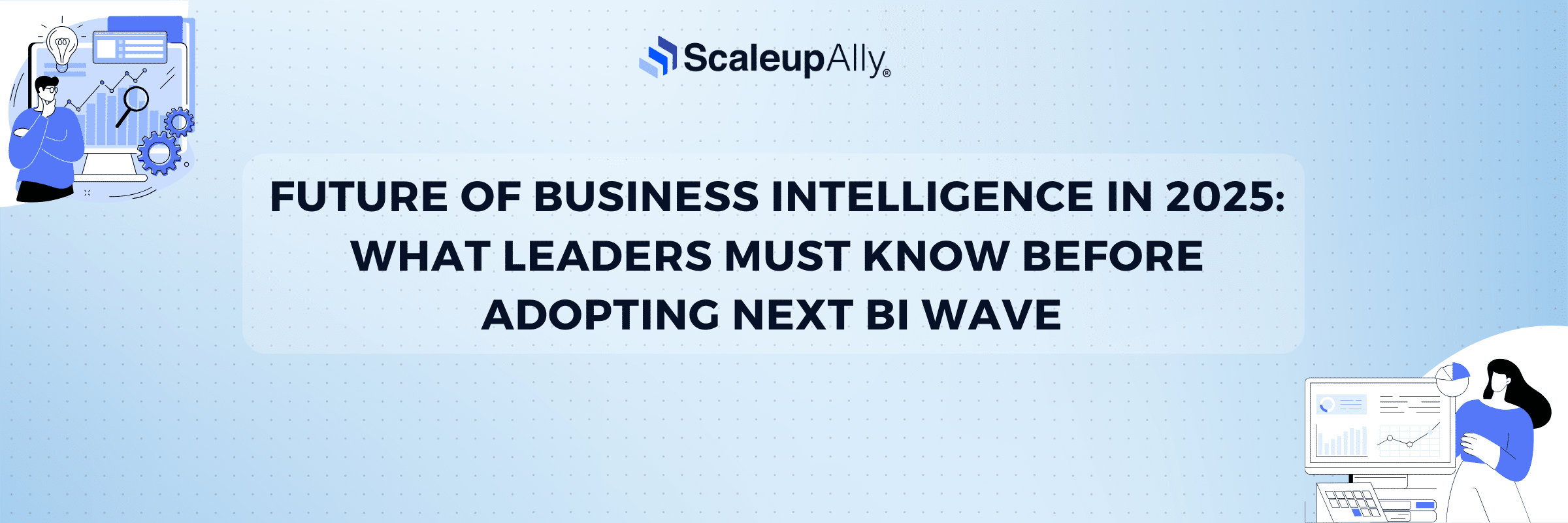
Future of Business Intelligence in 2025: What Leaders Must Know Before Adopting Next BI Wave
Tarsem Singh | June 27, 2025 , 13 min read
Table Of Content
The corporate boardroom used to be the final destination for business intelligence. Data would travel up through layers of analysts and get filtered and polished along the way until it reaches the C-suite as neat charts and executive summaries. That era is coming to an end.
By the end of 2025, the future of business intelligence will be about giving decision-making capabilities to everyone who touches data. The shift is already underway, and companies that still cling to old models will soon encounter roadblocks.
According to Gartner, 87% of organizations report low business intelligence and analytics maturity. Yet global spending on business intelligence is expected to reach $35.03 billion. Companies are investing heavily in BI tools—while admitting they’re not yet skilled at using them
Traditional BI assumes humans are the bottleneck and that people need simpler dashboards and cleaner reports. But the real bottleneck isn’t human comprehension. It’s the gap between insight and action.
Modern businesses generate 2.5 quintillion bytes of data daily. Meanwhile, the average employee spends 2.5 hours daily searching for information they need to do their job. This equation reveals a fundamental disconnect.
The next wave of business intelligence won’t just analyze what happened or predict what might happen. It’ll automatically decide what should happen next and in many cases, make those decisions without human intervention.
The leaders who understand this shift will build competitive advantages that compound over time. Those who don’t will find themselves managing yesterday’s tools while their competitors operate in tomorrow’s reality.
This blog explores what the future holds for business intelligence and its key trends.
Key Takeaways
- Instead of data insights being limited to executives and analysts, companies are moving toward giving all employees the ability to access and understand data for decision-making.
- Artificial intelligence is automating data analysis, making predictions, and even making decisions automatically. BI tools are moving beyond creating reports to actually taking action.
- Companies can no longer afford to wait days or weeks for data analysis; they need instant, up-to-date information to stay competitive in 2025.
- Instead of requiring technical skills to query databases, people can now ask questions about data using plain English. This is making analytics accessible to non-technical users.
- Business intelligence spending is expected to nearly triple from $35 billion to $116 billion by 2033, showing massive investment and adoption across industries.
What Does the Future Hold for Business Intelligence?
What does the future hold for business intelligence? It’s explosive growth driven by AI-powered transformation. The future of business intelligence is splitting into two distinct paths, and most leaders are betting on the wrong one.
Companies can’t afford weeks of data analysis anymore. They need insights yesterday. Cloud integration and big data tools are making instant intelligence accessible to businesses of all sizes.
Autonomous decision-making, real-time intelligence, and self-service Business Intelligence top the priority list for 2025.
Smart businesses are shifting from reactive reporting to predictive intelligence. The winners won’t just track what happened. They’ll know what’s coming next.
The BI market is skyrocketing from $35.03 billion in 2024 to $116.25 billion by 2033. That’s nearly triple the current market size.
Top 11 Trends in Business Intelligence to Follow in 2025
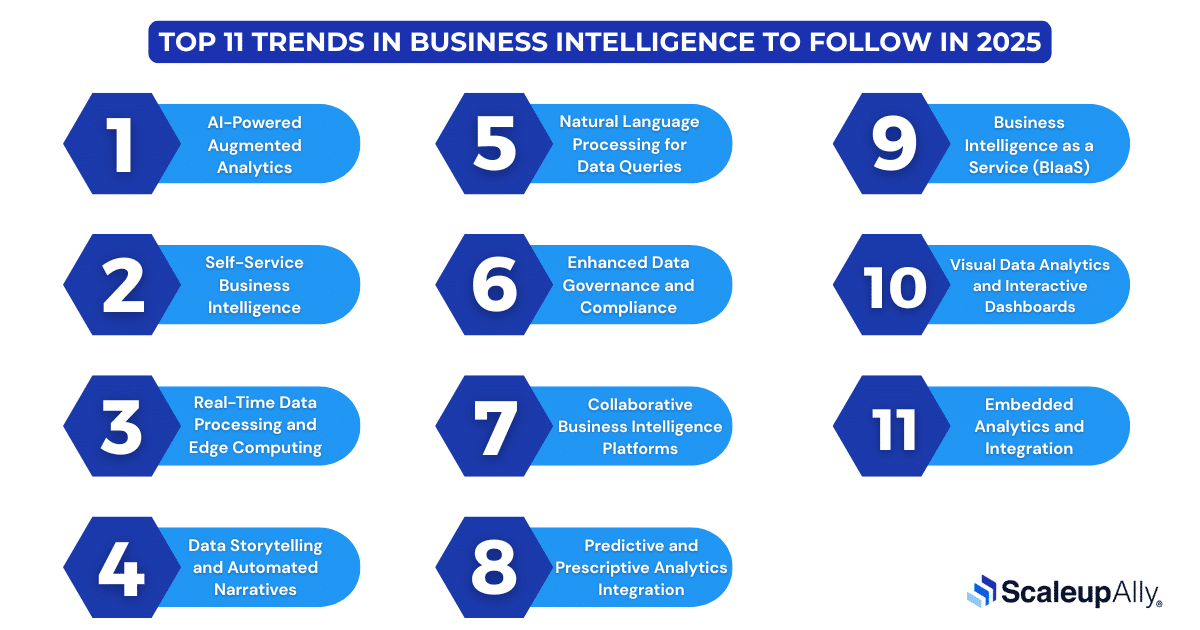
The business intelligence landscape after 2025 won’t look anything like today’s dashboard-heavy systems. These eleven trends are reshaping the future of business intelligence and how organizations extract value from data. Missing even one could leave your company relying on outdated intelligence.
1. AI-Powered Augmented Analytics
Augmented analytics uses AI and ML to enhance data preparation, discovery, and insight generation—and the numbers prove its explosive growth.
The global business intelligence market size was valued at USD 30.1 billion in 2024 and is projected to grow from USD 36.82 billion in 2025 to reach USD 116.25 billion by 2033, growing at a CAGR of 14.98%. This is a complete transformation of how companies handle data.
Think about it—your data analyst no longer needs to spend hours cleaning spreadsheets. AI does the heavy lifting while humans focus on asking better questions. Companies that have CEOs making data-driven decisions are 77% more likely to succeed according to Deloitte research, and augmented analytics is making those data-driven decisions accessible to everyone, not just the C-suite.
2. Self-Service Business Intelligence
The days of waiting weeks for IT to build your dashboard are over. Self-service BI puts analytical power directly into the hands of people who need it most, though adoption tells an interesting story.
Adoption rates for BI/analytics tools remain stuck in the 20% range, but that’s changing fast as barriers come down. Marketing managers can now build their own campaign performance reports. Sales directors create territory analysis without submitting endless tickets. Operations teams track their KPIs in real-time without depending on anyone else.
Companies use an average of 4 or more different BI tools to get a range of data analysis options. This fragmentation is exactly what self-service BI aims to fix by giving users one powerful platform instead of juggling multiple tools.
The math is simple. In 2025, the business intelligence software market is expected to witness an average spending per employee of $7.80. That’s accessible enough for companies to democratize insights across their entire organization.
3. Real-Time Data Processing and Edge Computing
If you’re still waiting for yesterday’s numbers to make today’s decisions, that approach died around 2023. The data explosion now demands real-time processing capabilities that traditional systems can’t handle.
In 2020, the world generated 64.2 zettabytes of data, and this number is projected to reach 181 zettabytes by 2025. That’s nearly a 300% increase in just five years. Without edge computing bringing processing power closer to data sources, companies risk drowning in information lag.
In 2025, we can expect to see the emergence of edge computing solutions that enable real-time data processing closer to the source, reducing latency and enhancing data accessibility. Manufacturing floors get instant quality alerts. Retail stores adjust pricing based on foot traffic patterns in real-time. Supply chains reroute automatically when disruptions hit.
The companies winning in 2025 are the ones making decisions with data that’s minutes old, not hours or days old.
4. Data Storytelling and Automated Narratives
Automated storytelling transforms complex datasets into stories anyone can understand. Sales dropped 15% last quarter becomes “Holiday shopping patterns shifted earlier, reducing Q4 traditional retail sales while boosting Q3 performance by 23%.”
After COVID-19, 49% of small businesses increased their use of data analytics, but they need those insights in plain language, not technical jargon. Data storytelling bridges that gap between raw analytics and actionable business understanding.
These are more than just attractive visualizations. They’re intelligent explanations that help decision-makers understand not just what happened, but why it matters and what to do next.
5. Natural Language Processing for Data Queries
Asking questions about your data shouldn’t require a computer science degree. NLP in business intelligence lets users query databases using plain English instead of SQL code, and adoption is accelerating.
By 2025, 95% of consumer interactions are anticipated to be assisted by AI, and business intelligence is following the same trajectory. “Show me which products performed best in the Northeast during flu season” becomes a simple conversation with your BI system.
In 2025 and beyond, NLP will become a popular way to make sense of complicated systems and digital tools. Voice assistants are used by 36.6% of Americans, while half of the mobile users use voice search every day.
The barrier between having questions and getting answers is disappearing fast, especially when 97% of collected data goes unused largely because people don’t know how to access it effectively.
6. Enhanced Data Governance and Compliance
With increased data capabilities comes greater regulatory responsibility. The statistics around data governance failures are sobering, but organizations are finally taking notice.
Gartner expects 60% of organizations will fail to realize the value of their AI analytics use cases with augmented analytics solutions due to incohesive data governance frameworks. That’s a massive failure rate, but it’s driving investment in better governance systems.
71% of organizations report having a data governance program in place this year, compared to 60% in 2023. That 11 percentage point jump in one year shows companies are getting serious about data management.
Companies are building comprehensive governance frameworks that balance innovation with compliance. They’re implementing automated data lineage tracking, establishing clear access controls, and ensuring audit trails that regulators accept.
Privacy regulations aren’t slowing down in 2025. They’re accelerating. Smart organizations are treating governance as a competitive advantage rather than a necessary evil.
7. Collaborative Business Intelligence Platforms
Data insights locked in individual dashboards don’t drive organizational change. Collaborative BI platforms let teams share discoveries, build on each other’s analysis, and create institutional knowledge that survives employee turnover.
As mentioned earlier, companies use an average of 4 or more different BI tools, creating data silos that collaborative platforms aim to eliminate. When analytics live in isolated systems, insights stay isolated too.
These platforms combine social media-style collaboration with analytical rigor. Teams can comment on trends, share hypotheses about data patterns, and collectively solve business problems using shared analytical workspaces.
8. Predictive and Prescriptive Analytics Integration
Looking backward at what happened is table stakes now. Predictive analytics is gaining traction as businesses look to forecast future outcomes based on historical data, but the real value comes from prescriptive analytics that suggests specific actions.
The global business intelligence market size was valued at $31.98 billion in 2024 & is projected to grow from $34.82 billion in 2025 to $63.20 billion by 2032. Much of that growth comes from organizations moving beyond basic reporting to predictive and prescriptive capabilities.
Modern BI platforms don’t just predict that customer churn will increase next quarter. They recommend which customers to contact, what offers to make, and when to reach out for maximum retention impact.
The evolution from “what happened” to “what should we do” represents the maturation of business intelligence from reporting tool to strategic advisor.
9. Business Intelligence as a Service (BIaaS)
Not every company needs to build its own analytics infrastructure from scratch. BIaaS solutions provide enterprise-grade business intelligence capabilities without the overhead of managing complex technical implementations.
The mobile BI market is set to reach $51.5 billion by 2032, and much of that growth comes from cloud-based, service-oriented deployments that small and medium businesses can afford.
Small and medium businesses can access the same analytical power that previously required massive IT investments. They get professional-grade dashboards, automated reporting, and advanced analytics without hiring data scientists or infrastructure specialists.
10. Visual Data Analytics and Interactive Dashboards
Static reports are becoming extinct. Interactive visual analytics let users explore data dynamically, drilling down into specific segments and discovering insights through exploration rather than predetermined reports.
Modern dashboards respond to user behavior, suggesting related metrics and highlighting anomalies automatically. The increasing adoption of data governance, visual data analytics, and augmented analytics reflects the industry’s commitment to innovation and efficiency.
The BI market is projected to reach $35.03 billion by 2025, with visual analytics driving much of that growth as organizations prioritize user experience alongside analytical power.
The best visualizations don’t just display information, they guide users toward actionable insights through intelligent design and interactive exploration.
11. Embedded Analytics and Integration
Business intelligence is moving out of standalone applications and into the software people use every day. CRM systems now include built-in analytics. ERP platforms offer real-time operational insights. Marketing automation tools provide campaign performance data without requiring separate logins.
The Business Intelligence Market size is estimated at USD 35.03 billion in 2025, and is expected to reach USD 56.48 billion by 2030, at a CAGR of 8.17%. Embedded analytics represents a significant portion of this growth as companies integrate intelligence into existing workflows.
This embedded approach eliminates context switching and puts insights directly into operational workflows. Sales reps see customer analytics within their contact management system. Inventory managers get supply chain insights inside their ordering interface.
When analytics live where decisions get made, they actually influence those decisions instead of gathering dust in separate reporting systems.
Conclusion
The business intelligence landscape is transforming at breakneck speed. These eleven trends are happening right now, reshaping how organizations understand their data and make decisions.
What strikes us most about the business intelligence future is how democratized it’s becoming. We’re moving from a world where insights were locked behind technical barriers to one where anyone can ask questions and get answers. That shift changes everything.
The companies that will thrive in 2025 won’t be the ones with the most data. They’ll be the ones who can turn that data into action fastest. Whether it’s through AI-powered augmented analytics, real-time edge computing, or natural language queries that feel like conversations, the future of BI belongs to organizations that embrace these trends instead of waiting for them to mature.
But we’re just scratching the surface. The convergence of AI, edge computing, and collaborative platforms is creating possibilities we couldn’t imagine just a few years ago. Companies that position themselves at the intersection of these trends will define the next decade of business intelligence.
Don’t let these opportunities slip by while competitors gain ground. Our team specializes in helping businesses navigate these emerging BI trends and implement solutions that deliver real results. Contact us today to discuss how these trends can work specifically for your business. Let’s turn those insights into action.
Frequently Asked Questions
Q: Is cloud-based BI the new standard going forward?
Yes, it is because cloud-based BI offers scalability, cost-effectiveness, and accessibility that on-premise solutions can’t match. With remote work becoming permanent and data volumes exploding, cloud deployment is quickly becoming the default choice for most organizations.
Q: How will AI affect business intelligence?
AI transforms BI from reactive reporting to proactive insights. It automates data preparation, discovers hidden patterns, generates natural language explanations, and predicts future trends. Essentially, AI makes business intelligence smarter and more accessible to non-technical users.
Q: Will self-service BI replace traditional BI?
Not entirely, but it’s shifting the balance. Self-service BI democratizes analytics for everyday users, while traditional BI still handles complex enterprise reporting and governance. The future combines both, empowering users while maintaining data integrity.
Q: What industries will benefit most from next-gen BI solutions?
Healthcare, retail, manufacturing, and financial services lead adoption. These industries generate massive data volumes and need real-time insights for competitive advantage. However, every industry benefits when data-driven decisions become faster and more accurate.
Q: How should businesses prepare for the future of BI?
Start with solid data governance, invest in employee training, and choose flexible platforms that grow with your needs. Focus on integration capabilities and ensure your BI strategy aligns with broader digital transformation goals.
Related Blogs
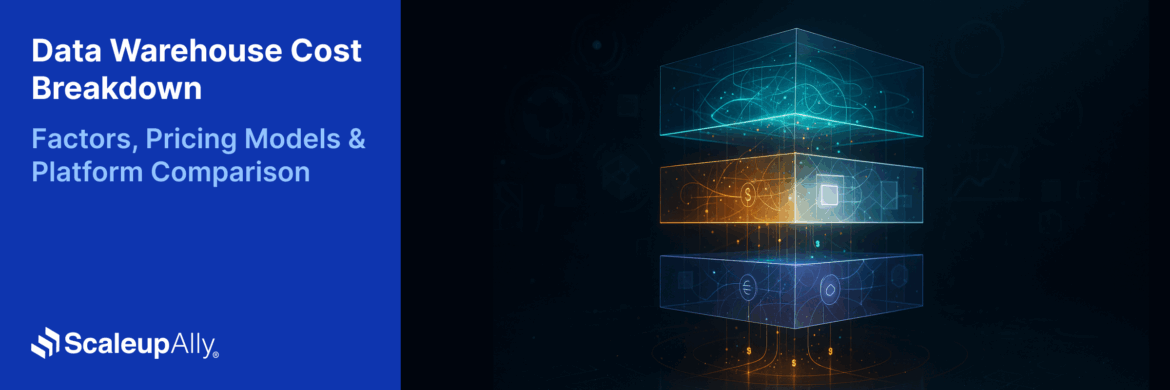
Data Warehouse Cost Breakdown: Factors, Pricing Models & Platform Comparison
Discover how much a data warehouse costs in 2025. Explore pricing models, key factors, and platform comparisons to plan your data budget effectively.
Tarsem Singh
Nov 6 ,
14 min read
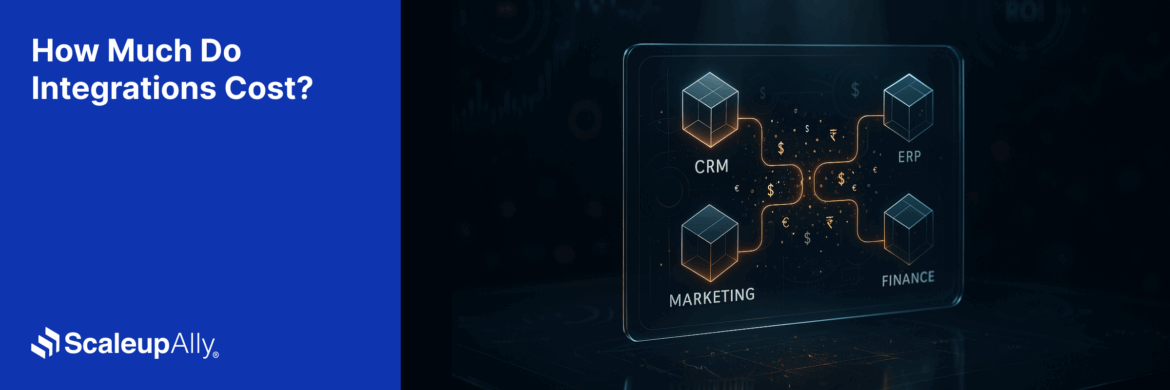
How Much Do Integrations Cost? [Pricing Breakdown & Key Insights]
Learn how much integrations cost, key factors influencing pricing, hidden expenses to avoid, and effective ways to reduce integration costs.
Tarsem Singh
Nov 6 ,
9 min read
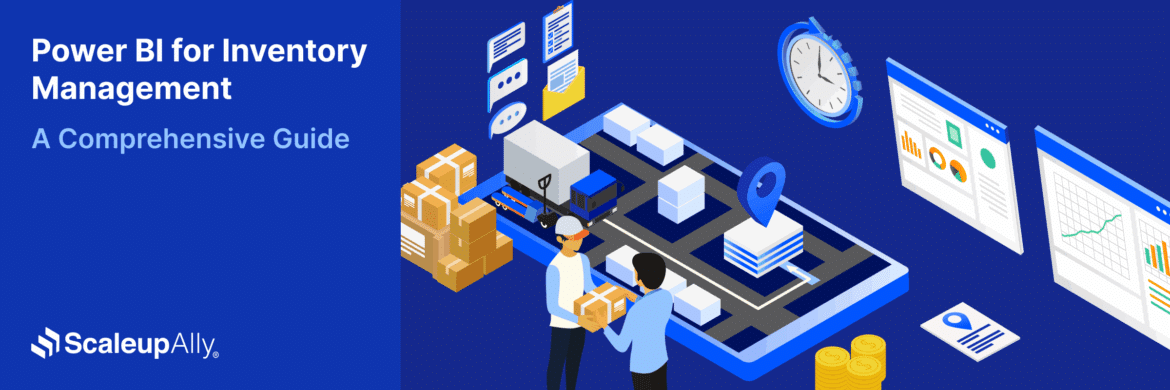
Power BI for Inventory Management: A Comprehensive Guide
Explore the hidden power of Power BI for inventory management and how it provides businesses with powerful analytics and visualization capabilities.
Tarsem Singh
Oct 8 ,
19 min read


